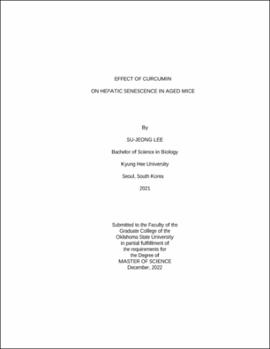| dc.contributor.advisor | Kim, Yoo | |
| dc.contributor.author | Lee, Su-jeong | |
| dc.date.accessioned | 2023-08-02T19:47:12Z | |
| dc.date.available | 2023-08-02T19:47:12Z | |
| dc.date.issued | 2022-12 | |
| dc.identifier.uri | https://hdl.handle.net/11244/338793 | |
| dc.description.abstract | Aging is a physiological decrease in several biological activities of organs that all organisms go through. The gradual deterioration of cell functioning due to damage accumulation in metabolic organs accelerates biological aging. Recently, dietary interventions with bioactive compounds have been linked to suppressing the accumulation of senescent cells and senescence-associated secretory phenotype (SASP). Curcumin has potent biochemical and biological activities, including antioxidant and anti-inflammatory actions. However, it remains largely unclear how curcumin exhibits its anti-aging properties such as protection from DNA damage and cell survival/cell fate decisions. The objective of this study was to examine the regulatory effect of dietary curcumin on hepatic cellular senescence in an aged mouse model. Aged (18-20 months old) male C57BL/6 mice were fed a normal chow diet (NCD) or NCD containing 0.4% (w/w) curcumin (NCD+CUR), high-fat high sugar diet (HFHSD) or an HFHSD+CUR (N=7-9 per group) for 8 or 15 weeks. Mice given HFHSD+CUR displayed a different metabolic phenotype compared to mice given an HFHSD alone. To examine the phenotypic plasticity led by transcriptomic alteration, RNA-Seq was used and analyzed differential gene expression using Gene Ontology (GO) terms and Kyoto Encyclopedia of Genes and Genomes (KEGG) pathway analysis. There were 1687 and 3794 genes that showed a significant change with curcumin in NCD and HFHSD groups compared to their respective control groups. Curcumin supplementation altered hepatic gene expression profiling, especially in senescence pathways and inflammatory pathways. Then this study mechanistically sought how curcumin regulates the hepatic senescence pathway. It has been found that curcumin supplementation decreased senescence effectors, specifically p38 protein expression levels in the liver. Also, we observed that curcumin modulates pro-inflammatory pathways: Cxcl2, Cxcl10, FoxO3, and IL-6 genes and NF-kB, p65, protein expression levels. By following the results, this study suggests that the multifaceted therapeutic potential of curcumin can be used as a protective agent for age-induced metabolic diseases. | |
| dc.format | application/pdf | |
| dc.language | en_US | |
| dc.rights | Copyright is held by the author who has granted the Oklahoma State University Library the non-exclusive right to share this material in its institutional repository. Contact Digital Library Services at lib-dls@okstate.edu or 405-744-9161 for the permission policy on the use, reproduction or distribution of this material. | |
| dc.title | Effect of curcumin on hepatic senescence in aged mice | |
| dc.contributor.committeeMember | Lin, Dingbo Daniel | |
| dc.contributor.committeeMember | Chowanadisai, Winyoo | |
| osu.filename | Lee_okstate_0664M_17940.pdf | |
| osu.accesstype | Open Access | |
| dc.type.genre | Thesis | |
| dc.type.material | Text | |
| dc.subject.keywords | aging | |
| dc.subject.keywords | cellular senescence | |
| dc.subject.keywords | curcumin | |
| dc.subject.keywords | p38 | |
| dc.subject.keywords | senescence-associated secretory phenotype | |
| dc.subject.keywords | SASP | |
| dc.subject.keywords | senolytics | |
| thesis.degree.discipline | Nutritional Sciences | |
| thesis.degree.grantor | Oklahoma State University | |
